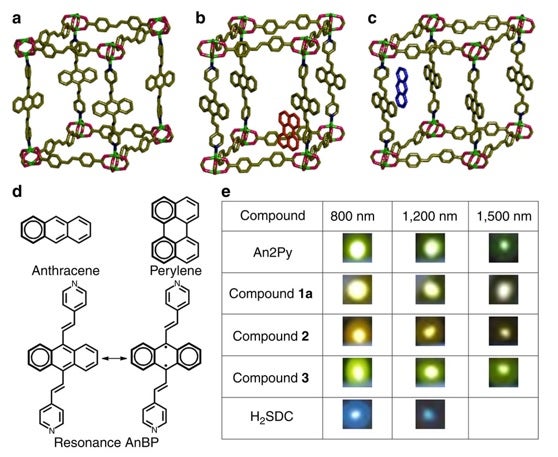Converting lower to higher photon energy emission
JJ VITTAL (Group Leader, Chemistry) () November 30, 201530 Nov 2015 NUS researchers with their collaborators from ICES discovered Near Infrared (NIR) Upconverting Metal Organic Framework (MOFs) materials for the first time.
Photon energy upconversion is the process whereby multiple low energy photons are combined to produce radiation of higher energy. It is particularly useful for high definition bioimaging, 3D displays, photovoltaics and high capacity data storage devices. However, it is challenging to design and synthesize solid state photoactive materials as emission properties are usually quenched due to aggregation of chromophores. MOFs are highly crystalline three-dimensional coordination polymeric compounds with very-well defined structures consisting of alternating metal ions or aggregates and organic spacer ligands. A team led by Prof JJ Vittal from the Department of Chemistry and Prof JI Wei from Department of Physics in NUS along with their collaborator from ICES presented a design strategy based on rigidifying the chromophores into well-structured architectural frameworks to achieve photon energy upconversion in MOFs.
Their approach is to design an organic ligand which has an electronic structure favouring intramolecular charge transfer and a biradical ground state. By long range spacing of the chromophoric ligands in MOFs, the solid state quenching has been reduced and efficiency of the upconversion process has been enhanced.
Typically, the infrared portion of the solar spectrum is not harnessed by optically active materials used in commercialized solar cells and photocatalytic system. By designing suitable materials that harvest not only the ultraviolet and visible light regime but also the infrared portion the solar radiation bestows on earth, the efficiency of solar cells can be boosted. Eventually, we envision the use of such upconverting MOFs in photovoltaics application.

a) A view of 1 showing without interpenetration. Solvents are omitted; (b) A view of 2 with encapsulated perylene (orange) guest; (c) a view of 3 with encapsulated anthracene (blue) guest; (d) Kekulé structures of anthracene, perylene and An2Py (resonance showing possible stabilized biradical structure); and (e) luminescence photos of An2Py, 1a, 2, 3 at 800, 1200, and 1500, nm femtosecond pulsed laser excitation. [Image credit: JJ Vittal]
Reference
Quah HS, Chen W, Q Martin, K Schreyer, Yang H, Wong MW, Ji W, Vittal JJ. “Multiphoton harvesting metal–organic frameworks. Nat. Commun.” 6:7954 (2015) doi: 10.1038/ncomms8954.


